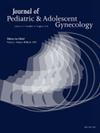Effect of Transdermal Estrogen Therapy on Bone and Neurobehavioral Health in Youth with Premature Ovarian Insufficiency: A Case-Control Study
IF 1.8
4区 医学
Q3 OBSTETRICS & GYNECOLOGY
引用次数: 0
Abstract
Study Objective
Estrogen replacement therapy (ERT) improves bone and neurocognitive health in adult women with premature ovarian insufficiency (POI). However, the response in adolescents is largely unknown. We aimed to assess the impact of transdermal estrogen replacement therapy on these outcomes in adolescents with POI.
Methods
Nine adolescents with idiopathic POI, naïve to ERT, and 9 controls with regular menses matched for age, race, and body mass index were recruited between 2018 and 2023 for a 24-month study. The primary bone health outcomes were changes in lumbar spine bone mineral density (BMD) Z-score and 3% distal radius trabecular volumetric BMD. The primary neurocognitive outcomes were quality of life (CHQ-87 survey) and memory (ChAMP).
Results
Adolescents with POI experienced significant increases in BMD Z-scores at all dual-energy x-ray absorptiometry skeletal sites (lumbar spine ∆ +0.68, total hip ∆ +0.37, femoral neck ∆ +0.56, total body less head ∆ +0.82, all P < .05). Control participants exhibited an increase in BMD Z-score at the total body less head (∆ 0.43, P = .034) with no significant change at other skeletal sites. There were no significant changes from baseline to 24 months in peripheral quantitative computed tomography measures. Total memory index significantly increased in both groups from baseline to 24 months (controls ∆ +17.2, cases ∆ +24.6, P = .041 and .001, respectively), but there was no difference between groups. There were no other significant differences in neurocognitive outcomes among or between groups.
Conclusion
Central BMD increased in adolescents with idiopathic POI in response to transdermal estrogen replacement therapy, but peripheral BMD measures were unchanged. The impact on neurocognitive outcomes in these adolescents remains uncertain.
经皮雌激素治疗对卵巢功能不全患者骨骼和神经行为健康的影响:一项病例对照研究。
研究目的:雌激素替代疗法(ERT)改善卵巢功能不全(POI)成年女性的骨骼和神经认知健康。然而,青少年的反应在很大程度上是未知的。我们的目的是评估经皮雌激素替代疗法(TDE2)对POI青少年患者这些结果的影响。方法:在2018-2023年期间招募9名特发性POI青少年,naïve至ERT,以及9名年龄,种族和BMI匹配的正常月经的对照组,进行为期24个月的研究。主要的骨健康结果是腰椎骨密度z评分和3%桡骨远端小梁体积骨密度的变化。主要神经认知结果为生活质量(CHQ-87调查)和记忆(ChAMP)。结果:患有POI的青少年在所有DXA骨骼部位的BMD z评分均显著增加(腰椎∆+0.68,全髋关节∆+0.37,股骨颈∆+0.56,全身少头∆+0.82,所有p均显著增加)。结论:特发性POI青少年在TDE2治疗后中枢性BMD增加,但周围BMD测量值不变。对这些青少年神经认知结果的影响仍不确定。
本文章由计算机程序翻译,如有差异,请以英文原文为准。
求助全文
约1分钟内获得全文
求助全文
来源期刊
CiteScore
3.90
自引率
11.10%
发文量
251
审稿时长
57 days
期刊介绍:
Journal of Pediatric and Adolescent Gynecology includes all aspects of clinical and basic science research in pediatric and adolescent gynecology. The Journal draws on expertise from a variety of disciplines including pediatrics, obstetrics and gynecology, reproduction and gynecology, reproductive and pediatric endocrinology, genetics, and molecular biology.
The Journal of Pediatric and Adolescent Gynecology features original studies, review articles, book and literature reviews, letters to the editor, and communications in brief. It is an essential resource for the libraries of OB/GYN specialists, as well as pediatricians and primary care physicians.

 求助内容:
求助内容: 应助结果提醒方式:
应助结果提醒方式:


